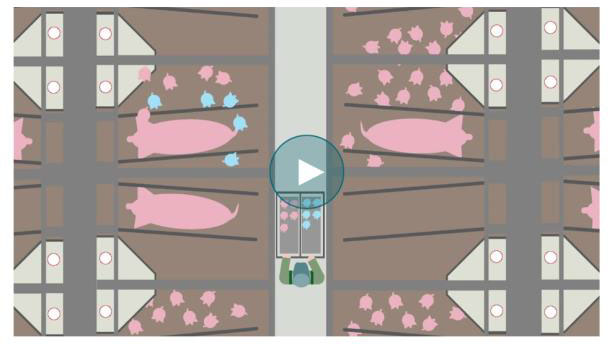Abstract: Local Anaesthesia and Analgesia to reduce pain in castration
Type and Average of Pigs on the Farm
1,200 sows, 48,500 weaners, and 46,900 grower-finishers.
Farming System
Intensive production system.
Description and Evaluation of the Good Practice
This farm uses local anaesthesia and analgesia during surgical castration to improve animal welfare, reduce pain, stress, and mortality in piglets. The practice was voluntarily introduced in 2019 and is now regulated by govern law. Personnel must complete mandatory training, including online and practical sessions led by veterinarians. The protocol includes combining castration with other routines (e.g., iron injections, vaccinations) to optimize timing and workflow. Tools are disinfected or changed between litters to prevent infection. Piglets show minimal reaction during castration and resume normal behavior quickly. The practice is monitored and has been tested for over six years.

Farm Context
- Pigs
Genetics: DanBred Landrace × Yorkshire (sows) and DanBred Duroc (boars)
Final weight: 118 kg
Slaughter age: ~5.5 months - Environmental Enrichment
Not specifically mentioned. - Housing and Management Characteristics
Floor type: Partly slatted floors
Feeding: Wet feed
Sow housing: Boxes
Piglet restraint: Castration bench
Labeling: Tattoo for finishers - Management Practices
Medicines: Pronestetic (max. 0.25 ml/testicle), Melovem (0.4 ml/pig)
Injection sites: Testicles (anaesthesia), neck (analgesia)
Needle size: 25G (0.5×16 mm)
Delay between injection and castration: 10–25 minutes
Time per litter: 7–8 minutes
Total time per batch: 7 hours
Staff: 4 people per batch
Castration performed on day 3–4 after birth by two people
Workflow includes equipment prep, piglet handling, anaesthesia, iron injection, earmarking, and castration
Economic Analysis
Estimated cost: 1 €/finishing pig
Environmental Analysis
No environmental impact reported.
Replicable Benefits and Relevance for Other EU Countries
This practice improves animal welfare and reduces mortality and infections. It is scalable to all farm sizes and sectors. Approximately 70% of male piglets in the country are castrated using this method. The GP is practical, feasible, and supported by video instructions. Benefits can be realized within one day to one month. The method is easily transferable across the EU.

